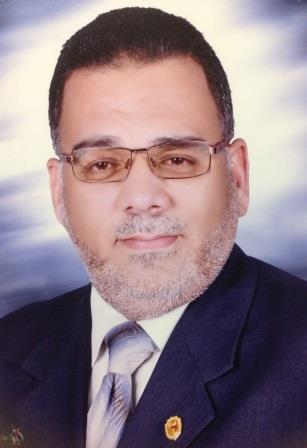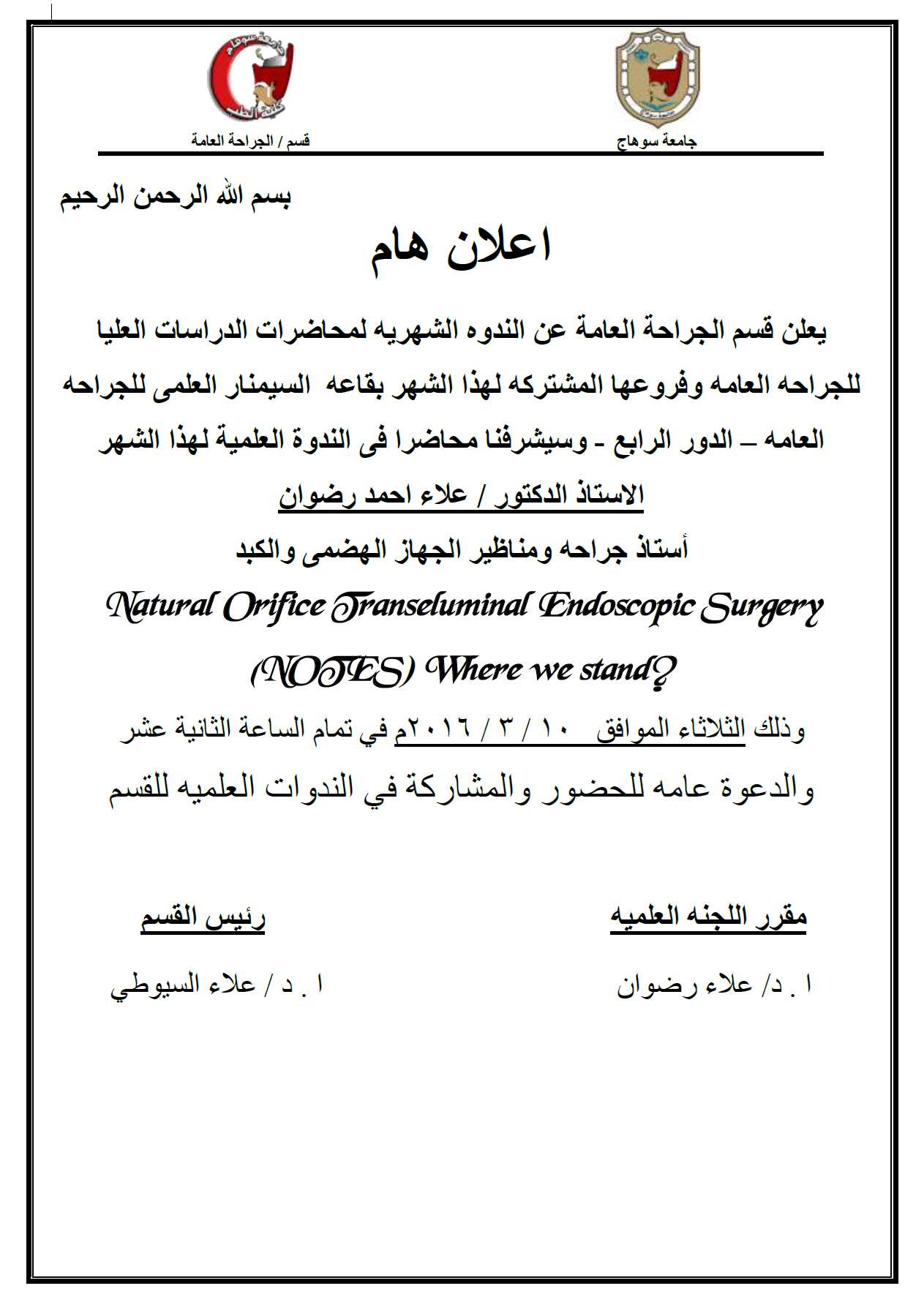Natural Orifice Transeluminal Endoscopic Surgery (NOTES)
Where we stand?
Change is a part of surgery and change is never easy to accept. At the dawn of surgery, excellence was associated with big incisions, hence the dictum: big surgeon – big incision.
In 1987, Philippe Mouret performed the first laparoscopic cholecystectomy. The Anglo-Saxon world called it the "second French revolution": Minimally invasive surgery was born representing one of the greatest surgical evolutions of the 20th century.
Since its inception in 2004 geared up by A. Kalloo, MD, the idea of endoluminal surgery has been proposed and documented.
Natural Orifice Translumenal Endoscopic Surgery:
Intentional puncture of one of the viscera (e.g., stomach, rectum, vagina, urinary bladder)
to access the abdominal cavity with an endoscope (flexible or stiff( to perform an intraabdominal operation
(Pearl JP, Ponsky JL: J Gastrointest Surg. 2007 Dec 5)
the new era revealed a new horizon of management of abdominal surgical techniques which communicate laparoscopy with gastro-enterology in the operation theater through Natural Orifice Transeluminal Endoscopic Surgery (NOTES).
It was started in Japan by Anubis project and it consist of four approaches:
- Trans-gastric endoscopic surgery
- Trans-urethral endoscopic surgery
- Trans-anal endoscopic surgery
- Trans-Vaginal endoscopic surgery
The field of flexible endoscopy has undergone a major paradigm shift from a simple diagnostic tool to an advanced interventional and surgical tool capable of sophisticated diagnosis, and surgical therapies of gastrointestinal as well as peritoneal and thoracic structures.
NOTES is the extension of the flexible endoscope's capabilities to reach organs outside the lumen of the bowel for the purposes of diagnosis, and treatment including resective therapies, such as appendectomy, cholecystectomy, or splenectomy.
Apollo-Olympus projects (1997(
- Wide spread mucosectomy procedures
- Endoscopic suturing skills, and instruments (e.g Eagle claw(
- Endoscopic treatment of GERD.
- Transgastric endoscopic surgery.
- Transgastric peritoneoscopy (Kalloo & Kantsevoy , 2000(
- Transgastric gastrojejunostomy (Kalloo & Kantsevoy , 2002(
Initial concept of natural orifice surgery:
*- Puncture of the stomach wall ( e.g. diathermy needle)
*- Balloon dilation of the puncture wound.
*- Entrance of the peritoneal cavity by the scope.
*- the surgical procedure proposed to be done .
*- Gastric closure
Advantages of NOTES:
*- Less invasive
*- Avoidance of wound and its infections
*- Less pain and the need for analgesics
*- Decreased post-op. ileus, and improve recovery
*- Perfect cosmetic results
*- More rapid recovery
*- Less adhesions
*- No abdominal wall hernias
*- Better approach for obese patients
*- Increase patient acceptance of surgical procedures
NOTES promises to complete the evolutionary arc from open to laparoscopic to no-scar surgery. In the race to do so, however, it is important to ensure that we do not make the same mistakes which were observed at the dawn of the laparoscopic era with subsequent impact on its rapid uptake.
Another factor which further complicates the NOTES era is the fact that it will be practiced by both surgeons and gastroenterologists who have not had common channels of information, training and oversight. The creation of a common task force helps to provide guidelines for safe conduct and adoption of these new therapies.
Although Transgastric access to the abdominal cavity seems to be the route that will dominate NOTES in the future, there are still some challenging issues, such as risk of infection or leakage and the method of gastric closure, that will need to be addressed before this technique is popularized. In contrast, Transvaginal access is well established and accepted. It has been used for years by gynecologists for diagnostic and therapeutic purposes (e.g. hysterectomy, myomectomy, adnexectomy, and fertiloscopy). In addition, surgeons have used this route to extract large specimens after laparoscopic procedures involving the gallbladder, colon, spleen, and kidney.
Transvaginal cholecystectomy is claimed to be pain-free, scar-free, and without bleeding. An initial procedure performed in France , and Published in the Archives of Surgery . The technical term is colpotomy (through the cervical vault). A flexible videogastroscope and standard endoscopy instruments were used, it took 3 hours. There was no postoperative pain, and the patient was sent home on the 2nd postoperative day; the NOTES enthusiasts are looking forward in offering 'invisible mending', although it will likely be more expensive than other approaches.
The world first, called "operation Anubis", was presented at the Japanese Congress of Surgery in Osaka on April 6th and during the Congress of the Society of American Gastrointestinal Endoscopic Surgery (SAGES) last week-end in Las Vegas.
Anubis was the ancient god in Egyptian mythology who restored Osiris to life through mummification using long, flexible instruments. The project was named after this reference.
An important step was made by the Columbia group in New York, United States on March 20th, 2007 when a hybrid transvaginal cholecystectomy was performed with the assistance of three laparoscopic trocars (New York Times, April 20th, 2007 - San Francisco Chronicle, April 20th, 2007 - SAGES Annual Meeting, Las Vegas, April 22nd, 2007.
Operation Anubis performed without incision, save from using a 2mm needle allowing for insufflations and control of intra-abdominal pressure, represents an extremely important step towards totally non-invasive surgery. The next challenge will be to validate other approaches, the transgastric route being the most appealing.
The justification of this technique are: the reduction or absence of postoperative pain, ease of access to some organs, the absence of trauma to the abdominal wall, ideal cosmetic results and the psychological advantages of eliminating the bodily trauma represented by surgery. Lastly and as pointed out by P. Swain, this provides proof that there are no limits to how human ingenuity and technology can reduce the physical and emotional trauma related to the surgical act.
The successful performance of the operation at the University Hospital in Strasbourg, is the results of three years of research under the Anubis project, labelled by the "Therapeutic Innovation Biocluster".
Since the editorial of July 2006, the field of NOTES has grown exponentially. The lesson learned from the advent of laparoscopic surgery is that we could now be witnessing the third surgical revolution. By nature surgeons are innovators and it seems that NOTES is here to stay.
A growing number of teams developed new surgical procedures of increasing complexity. Without a doubt, the development of laparoscopic cholecystectomy was a phenomenon that changed the focus of surgery and the mindset of nearly all surgeons. For this reason the initial project focused on transgastric approach which seemed to be the most logical and appealing clinical application. The results obtained by NOTES opened the door to new, more complex procedures.
Time line for NOTES:
Nov. 2006. Publish transgastric appendectomy
Feb. 2007. Publish transcolonic access
March 2007. Publish venteral hernia repair
May 2007. Publish 1st human NOTES – PEG rescue
May 2007. Human transvaginal cholecystectomy – hybrid (Brazil, New York, France)
June 2007. 1st human transgastric cholecystectomy - hybrid (Swanstrom)
March 2008. Transgastric appendectomy – hybrid ( Horgan/ Talamini/Savides)
- 1st Human transvaginal sleeve gastrectomy (Brazil)
Obstacles to NOTES:
Surgeons lack skills in flexible endoscopy
Gastroenterologists lack surgical experience/ principles and access to OR
Access (peritoneal cavity)
Closure (gastric – colonic) – flexible stapler
Suturing – Eagle claw
Anastomosis
Spacial orientation
Multi- tasking platform – robotics
Management of intra-operative events
Physiological untoward events
Training
White paper – Gastrointest. Endosc. And Surg. Endosc. 2006


